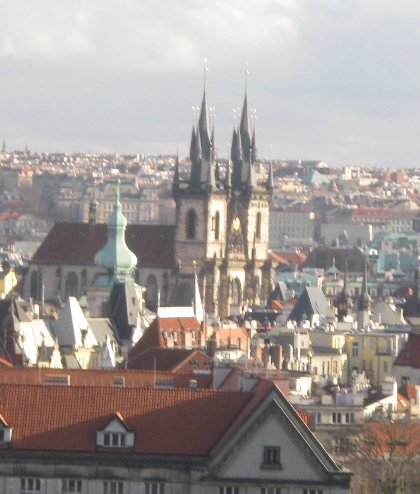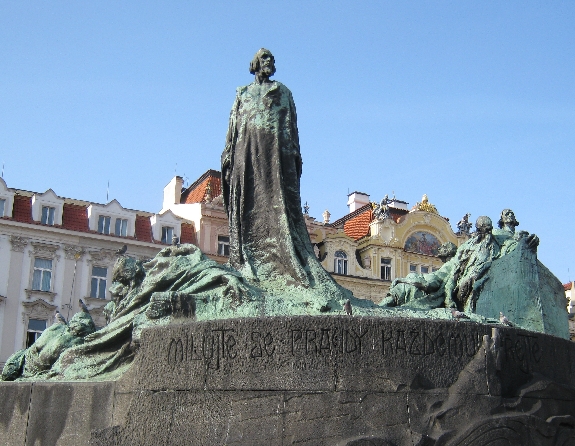Before 2015 comes to an end, I want to try and write, at least briefly, about all those things that happened in the second half of this year, but which never got the blog post they deserved – a combination of my own ill health and the excessive heat we experienced during the summer months. It will take two posts, so here is the first. And the second has now been written and published.
July

Monday 6th July marked the 600th anniversary of Jan Hus, the early Czech Church reformer, being burnt at the stake in Konstanz on 6th July 1415. As I have previously explained, during the past two hundred years, Czech people have tended to celebrate Hus as a political and cultural hero. His opposition to church control by the Vatican gave strength to those who opposed control of Czech lands by the Austro-Hungarian Empire. He preached and wrote in the Czech – language is the main factor in Czech national identity. Even the Communist regime tried to claim Hus as a proto-communist!


Therefore it was pleasing to see the main non-Roman Catholic Churches take the lead in organising events in Prague over a long weekend 4th – 6th July, to mark the 600th anniversary of Hus’s martyrdom. They took place on two stages erected either side of the newly renovated statue of Hus in Old Town Square, culminating in an open air Ecumenical service celebrating the life and teaching of Hus and broadcast live on Czech radio. It was good to see and hear Hus being commemorated for who he really was, with his spiritual legacy being reclaimed and proclaimed.

The other pleasing aspect were the efforts made by the Roman Catholic Church, to finally acknowledge their own history and responsibility for the death of Hus. Cardinal Vlk, the now retired, but still active, former RC Archbishop of Prague, spoke at the service, bringing a personal message from Papa František/ Pope Francis. At the end of his address there was applause, showing appreciation for the conciliatory nature of the message.

On the morning of Friday 10th July, I attended, along with Lea Williams, the last part of the Fifth Conference of representatives of the Cross of Nails Community in Central and Eastern Europe which was being held in Prague that week. The conference ended with a Festive Service at which the Dean of Coventry Cathedral, Very Rev’d John Witcombe, gave a address on the theme, ’75 Years of Peace Efforts by Coventry Cathedral – Turning enemies into friends’. Following the service, we were all invited to lunch at the Roman Catholic Archbishop of Prague’s dining hall where this photograph was taken.

On the morning of Sunday 26th July, we had the pleasure of the Choir of Little St. Mary’s, Cambridge, UK, enhancing our worship at our Sung Eucharist. Like previous visiting choirs, they very much enjoyed the excellent acoustics of the Church building, as well as the splendid organ. During their visit to Prague, they had a group photograph taken in each of the places where they sang. Therefore following worship, the choir posed on the chancel step, along with their travelling supporters, and insisted that I be in the middle of the photograph 🙂
August
The first half of August was dominated by my hospitalisation with a pulmonary embolism, about which I did manage a blog post of explanation. However, I was very pleased to eventually be given clearance by my GP, to spend Tuesday 18th – Monday 24th August, walking with Sybille in Germany, from Görlitz to Kamenz, along the first part of Der Ökumenische Pilgerweg. That week has to have its own blog post or posts, even if it isn’t written and published until early 2016.

As I explained in the post about my hospitalisation, one consequence is that I have had to retire from playing cricket. I have therefore donated all of my cricket kit – batting pads and gloves, wicket-keeping pads, gloves & inners, along with my box 🙂 , to the Prague Barbarians Cricket Club, for whom it has been my privilege to play for the past six summers. In turn, Terry the club captain, kindly organised a dinner in my honour to mark my retirement, attended by a number of my playing colleagues.
September
On each of the first two Saturdays of September, I conducted a wedding. In both cases it was British male marrying Czech female.
On Saturday 5th September, I conducted the wedding of Paul and Michaela, the couple who own and run Sansho, the dégustation restaurant where Sybille and I celebrated our joint birthdays earlier this year. Their wedding took place in the grounds of Trojanuv mlyn, Tiche udoli, a peaceful rural location just within the Prague city boundary. Unlike in England and Wales, outdoor weddings are permissible under Czech marriage law.
 |
 |
Using the liturgical texts that I gave her, Michaela had an attractive Order of Service produced, the cover matching their wedding invitations. Michaela’s brother Aleš, kindly helped me with the liturgy, enabling Michaela to make her vows in Czech whilst I helped Paul make his in English. Meanwhile, the very supportive congregation, sat on straw bales, surrounded by trees to witness the ceremony. It does have be said that I heard numerous, ‘It’s about time too’ comments, from friends and family, very pleased that Paul and Michaela had finally tied the knot 🙂
On Saturday 12th September, I conducted the wedding of Charles and Radka, a couple who I first met at the beginning of 2015, when they started worshipping at St. Clements, having just got engaged. Whilst Charles is a baptised and confirmed Anglican, it was a wonderful to hear Radka profess Christian faith and to baptise her as an adult, during our Easter Day Eucharist earlier this year.
Their wedding took place in Kaple Nalezeni sv Križe, Malé Cicovice, adjacent to the Penzion where they held the reception following their marriage service. Malé Cicovice lies north-west of Prague, not far from Kladno. On this occasion, Renata and Eva, two friends of Radka, helped her make her vows in Czech, whilst I did likewise for Charles in English.
 |
 |
 |
 |
Whilst we didn’t sing any hymns, I drove Larry Leifeste and his wife Celieta, from Prague to the wedding venue, so Larry could play the ancient chapel organ to provide music before the service, for the entrance of the bride, and for the happy couple leaving at the end of the service. It did make for a most enjoyable occasion, helped by some warm and sunny weather.
Between Thursday 24th – Sunday 27th September, I attended the 2015 meeting of the Eastern Archdeaconry Synod, which this year took place in a Roman Catholic conference centre, just outside Zagreb in Croatia. In past years, each Archdeaconry Synod meeting has had its own blog post, but in 2015……
Three highlights from this year’s meeting were:
1) Our long-standing and long-suffering Archdeacon Patrick Curran, formally stepped down as Archdeacon of the East and thus ceased to be ‘venerable’ 🙂 I’ve never seen Patrick so relaxed – he was very much demob happy 🙂 Patrick was presented with an icon of St Cyril & St Methodius by the Chaplaincies of the Archdeaconry, and with a framed map of Europe, together with an ‘interesting’ bottle, by Bishop Robert.
 |
 |
In his place, we formally welcomed our new ‘free-standing’ Archdeacon, Colin Williams. Colin is now half time Archdeacon of the East, and half time Archdeacon of Germany and Northern Europe. But unlike Patrick, who remains Chaplain of Christ Church, Vienna and oversees the daughter congregations in Klagenfurt, Ljubljana, Zagreb and Yerevan, Colin has no responsibility for a particular chaplaincy, hence he is deemed ‘free-standing’.
2) During our Sunday morning Eucharist, Janet Berkovic, who brilliantly organised the Zagreb Synod meeting, was licensed as a Reader by Bishop Robert. Janet has led the small Zagreb Anglican congregation for many years, under the long distance guidance of Patrick from Vienna.
 |
 |
Three years ago at our Synod meeting in Athens, Jack Noonan was licensed as a Reader to serve the Prague Chaplaincy. It was during that licensing service that the Holy Spirit spoke to Janet saying she should also offer herself to train as a Reader, something Patrick had been suggesting to her for several years. So she is now licensed as ‘Reader-in-charge of Zagreb’, but still under Patrick’s jurisdiction. An additional highlight under the Berkovic heading, is that Janet’s Croatian husband Danijel, a Hebrew scholar, gave us three brilliant expositions of the Psalms, particularly bringing out things that are so easily ‘lost in translation’.
3) On the afternoon of Sunday 27th September, after a tour of central Zagreb, we were invited to coffee and refreshments at the new headquarters building of the Croatian Roman Catholic Bishops Conference. Here we met the chairman of their ‘Ecumenical Committee’, together with one of their bishops. Whilst our Zagreb Anglican congregation use Roman Catholic premises for their services, the Anglican congregation is not recognised as a ‘Church’ in Croatia – they function as a ‘voluntary organisation’.
Therefore having Bishop Robert with us made quite an impact, most notably when he spoke, with Danijel Berkovic translating. I still remember the look of total surprise on the face of the RC bishop, when Bishop Robert said he was responsible for just over three hundred Anglican congregations scattered across Europe. With only seeing one little congregation of English-speaking Anglicans in Zagreb, they had no idea of the size of the Church of England in continental Europe, let alone the wider Anglican Communion.











